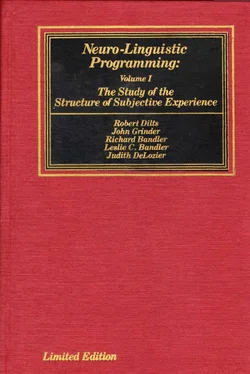
An example of how to employ such a procedure is demonstrated in a case in which one of the authors was working with a man who had a long, cumbersome and inefficient decision making strategy. This individual would spend hours or even days in deliberation, putting off decisions for so long that he would invariably end up passing by key opportunities, which would cause him to feel bad. As a consequence he would become deeply agitated and angry with himself for having wasted so much time. The author redesigned his decision strategy such that the individual would take into consideration the possibilities of missing key opportunities and wasting time (this becomes a representation of the outcome sequitur for the outcome of not making a decision on time) at a much earlier point in his strategy. This helped provide a motivation for the individual to speed up the strategy process by considering the possible outcomes of over deliberation, and served as a resource to provide a time check in the decision process. The inclusion of this test for negative feelings served as a decision point in the strategy at an earlier stage.
This strategy was installed by asking the person what it was like at the end of his strategy when he began to realize how much time he had wasted and how he may have possibly missed important opportunities. As the man responded, the sequence of representational systems was anchored kinesthetically ( ∮ Ke) with a squeeze on his knee. The individual was then asked to tell the author about a decision that he would soon be required to make, or a decision that he was deliberating on at present. The individual responded by telling the author about some decision he had been trying to make without getting anywhere. As he began to relate some of the details, the author reached over and squeezed his knee. The man stopped in mid-sentence. And, by observing his accessing cues, the author could tell he began to go through the anchored subroutine. Within moments the individual had come up with at least five things, that would bear upon the decision, that he needed to do. The author then repeated the process with a number of other current decisions the person needed to make, squeezing the individual's knee during the first few decisions they discussed, and witholding the anchor for the last three, as a test to make sure the new strategy was now installed. The installation of the new strategy was so successful that the individual is now the owner of the company that, at that time, had employed him as a secretary.
6.12 Anchoring Individual And Unrelated Strategy Steps.
Individual representational steps may be pulled out of totally unrelated strategy sequences, anchored and then reanchored together in sequence to form a new strategy. For instance, a certain form of internal dialogue may be taken from one naturally occurring strategy, the ability to see clearly externally from another and some internal kinesthetic check or test from yet another. These three representational functions may then be anchored together in a variety of orders and sequences to generate new outcomes and experiences for the individual. The programmer may, for instance, anchor first the ability to see clearly externally, then the internal dialogue, thirdly the positive kinesthetic feelings, and finally the ability to see clearly is anchored again so that the individual may exit again to external experience to gather feedback as more input.
The anchors used to trigger the appropriate strategy step may be kinesthetic (as with touches on various places on the individual's body) or in another representational system such as internal or external visual cues. Words, of course, are anchors (see discussion of language as secondary experience in Patterns II ), and have the advantage of being culturally standardized to some degree. The programmer, then, may sequence representations using verbal anchors (this can be more generally recognized as "giving instructions").
The effectiveness of your anchoring can be increased by pairing and combining more than one anchor for the particular strategy step. Anchors in different representational systems may be paired to increase their effect as you install the strategy sequence.
Consider the following transcript of one of the authors installing a learning strategy in a participant at one of his workshops. The strategy he has designed and is installing is the one described in the preceding example:

TRANSCRIPT
AUTHOR: Now to begin the installation process, I want to get some good reference structures for you for the kinds of operations we're going to be putting together. First, I'd like you to think of a time when you could see very clearly (author raises his voice slightly to establish a tonal as well as digital auditory anchor— ∮ Ae) what was going on in your immediate environment . . . Can you think of a time?
SUBJECT: Ahh . . . (breathing shallows and moves into his chest, eyes flick up and left) . . . Ahh, yes ... I have one.∮
A: (Squeezes S's forearm— ∮ 1 Ke) Good . . . Now what I want you to do is look at what is going on now around you . . . and keep looking until you can see very clearly (raises tonality— ∮ Ae t,d) squeezes S's forearm— ∮ 1 Ke) the people, motions, colors and any other details you can notice . . . (Pause while S carries out task — A continues squeezing S's forearm). Fine . . . (releases anchor) . . . Has there ever been a time when you were able to comment explicitly to yourself (slows voice tempo— ∮ 2 Ae) about something that was going on around you?
S: Umm . . . (looks up and left).
A: (Laughs) You won't find it up there.
S: Huh?
A: Never mind.
S: Oh . . . Okay . . . Ummm ... a time when I was talking to myself about what was going on around me . . . (eyes move down and left).
A: (Laughs, reaches down and squeezes knee— ∮ 2 Ke) You were doing it just now.
S: I was? . . . Oh . . . (Laughs) . . . Well, I thought of another time too.
A: Okay ... Good . .. What is that like.... can you comment explicitly to yourself (slows voice tempo— ∮ 2 Aet,d) on what I'm doing right now? (A makes a series of gestures and movements with one hand, squeezes S's knee with the other— ∮ 2 Ke) . . . All right . . . (releases anchor) . . . Now . . . has there ever been a time when you were thinking about something and you had to get in touch with your feelings and check it out (deepens tonality— ∮ 3 Aet,d) for yourself?
S: Mmmm . . . (eyes move down and right) . . UhHuh . . . Sort of . . .
A: (Beginning to squeeze S's shoulder) . . . Exaggerate it then . . . get in touch with those feelings and keep checking it out (deepens tonality— ∮ 3 Aet,d, squeezes S's shoulder— ∮ 3 Ke) until you are really sure.
S: (Eyes and head down and right) . . Yeh . . . (nods) . . . Okay . . . (breath shifts to stomach.)
A: (Releases anchor) Wonderful. . . . Very good . . . Now I'd like to try something out. . . You've been wanting to learn accessing cues haven't you?
S: (Nods vigorously) Oh yes.
A: All right . . . Do you know the generalizations pretty well? Do you know what the eye movements mean?
S: Sort of . . . (shakes his head "no" unconsciously).
A: (Laughs) Your unconscious mind doesn't seem to think so.
S: What?
A: You were just now shaking your head "no."
S: Oh ... (smiles) ... You're right... I guess I was shaking it "no."
Читать дальше













